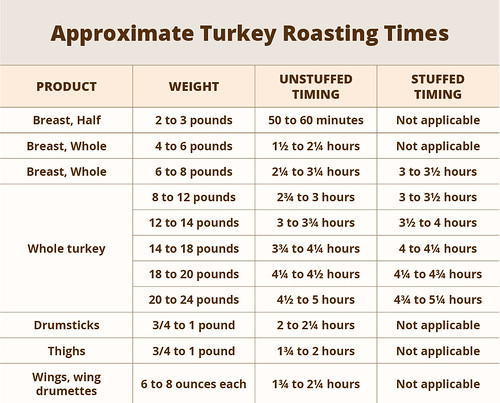Handling the Holiday Turkey – Food Safety Tips
go.ncsu.edu/readext?969536
en Español / em Português
El inglés es el idioma de control de esta página. En la medida en que haya algún conflicto entre la traducción al inglés y la traducción, el inglés prevalece.
Al hacer clic en el enlace de traducción se activa un servicio de traducción gratuito para convertir la página al español. Al igual que con cualquier traducción por Internet, la conversión no es sensible al contexto y puede que no traduzca el texto en su significado original. NC State Extension no garantiza la exactitud del texto traducido. Por favor, tenga en cuenta que algunas aplicaciones y/o servicios pueden no funcionar como se espera cuando se traducen.
Português
Inglês é o idioma de controle desta página. Na medida que haja algum conflito entre o texto original em Inglês e a tradução, o Inglês prevalece.
Ao clicar no link de tradução, um serviço gratuito de tradução será ativado para converter a página para o Português. Como em qualquer tradução pela internet, a conversão não é sensivel ao contexto e pode não ocorrer a tradução para o significado orginal. O serviço de Extensão da Carolina do Norte (NC State Extension) não garante a exatidão do texto traduzido. Por favor, observe que algumas funções ou serviços podem não funcionar como esperado após a tradução.
English
English is the controlling language of this page. To the extent there is any conflict between the English text and the translation, English controls.
Clicking on the translation link activates a free translation service to convert the page to Spanish. As with any Internet translation, the conversion is not context-sensitive and may not translate the text to its original meaning. NC State Extension does not guarantee the accuracy of the translated text. Please note that some applications and/or services may not function as expected when translated.
Collapse ▲In the rush of the holiday season, it’s nice to get ahead of the chaos and make a plan. Whether you’re looking for that perfect side dish recipe or wanting to can some cranberry chutney before the big day, having a plan can help alleviate stress and ensure an enjoyable holiday. Tackling the turkey can often be an overwhelming hurdle, but we can help by answering some commonly asked questions for a safe and healthy holiday!
Q. What size turkey do I need for my family?
A. The National Turkey Federation recommends ¾ -1 pound of uncooked turkey per person. If you want to have leftovers you will of course want to add to that amount.
Q. How long will it take to thaw my turkey?
A. The USDA advises that for every five pounds of turkey allow 24 hours in refrigerated temperatures for adequate and safe thawing. A 15 pound frozen bird will take 3-4 full days to thaw in the refrigerator. Plan the date of purchase and allow enough refrigerator space for thawing. If you are rushed for time, thaw in, cold water making sure water is not able to leak through wrapping. Change the water every 30 minutes. The turkey will take about 30 minutes per pound to thaw. Refrigerate at 40°F or below or cook turkey immediately after it is thawed. Do not refreeze uncooked, defrosted turkey.
Q. What if I want to buy a fresh turkey?
A. If you want to buy a fresh turkey, wait until the Tuesday before Thanksgiving. Some grocery stores will let you reserve a fresh turkey.
Q. Should I wash my turkey before cooking it?
A. NO! Washing poultry before cooking it is not recommended. Bacteria in raw meat and poultry juices can be spread to other foods, utensils, and surfaces. We call this cross-contamination. Some consumers think they are removing bacteria and making their meat or poultry safe. However, some of the bacteria are so tightly attached that you could not remove them no matter how many times you washed. But there are other types of bacteria that can be easily washed off and splashed on the surfaces of your kitchen. Failure to clean these contaminated areas can lead to foodborne illness. Cooking (baking, broiling, boiling, and grilling) to the right temperature kills the bacteria, so washing the turkey is not necessary.
Q. How can I best determine if my turkey is done?
A. A whole turkey is safe cooked to a minimum internal temperature of 165°F. Throughout the bird. Check the internal temperature in the innermost part of the thigh and wing and the thickest part of the breast. All turkey meat, including any that remains pink, is safe to eat as soon as all parts reach at least 165°F. The stuffing should reach 165°F whether cooked inside the bird or in a separate dish.
Q. How much time should I allow for my Turkey to get to the proper temperature?
A. See the below chart on approximate cooking times.
Q. What is the safest way to handle holiday leftovers?
A. Chilling food safely reduces the risk of foodborne illness. Place leftovers in shallow containers. Refrigerate (40°F or below) or freeze the cooked poultry and sides dishes within two hours after cooking. Use refrigerated leftovers within three to four days.
More Resources:
- Safe Plates, NC State Extension
- USDA Food Safety
- USDA Meat & Poultry Hotline: 1-888-674-685






